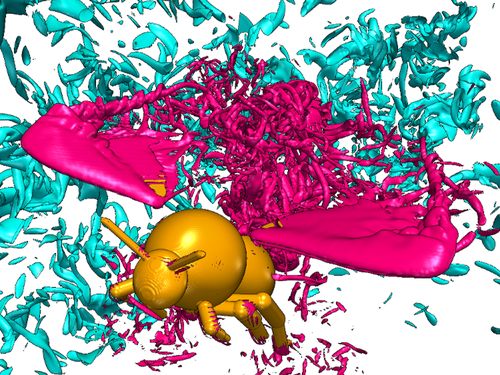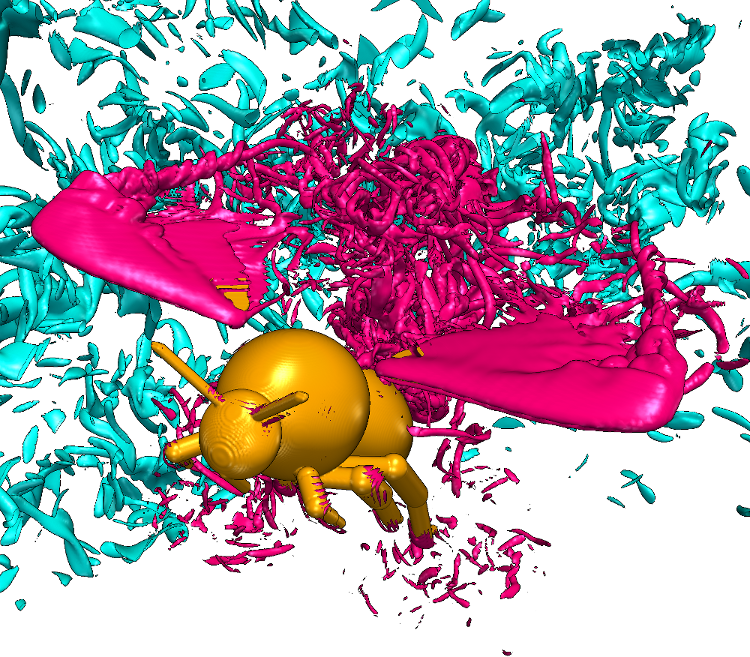Bumblebees In Turbulence
The frenetic intensity in the musical piece Flight of the Bumblebee might suggest a bee struggling to fly through swirling winds. A group of researchers has now explored this very situation, simulating the flight of an insect in turbulence. They were surprised to find that their virtual bumblebee did not require more force or exert more energy staying aloft in turbulent air flow than in smooth air. The results could benefit the design of bug-sized drones.
Fixed-wing flyers like airplanes generate lift by inducing a pressure difference between the air flowing above and that flowing beneath the wings. However, this flow pattern can be disrupted by the chaotic air motion in turbulent weather, resulting in sudden changes in the lifting force. Whether this sort of instability occurs for flapping-wing flyers is an open question and one that has implications for the development of micro air vehicles (MAVs), some of which are designed to mimic nature’s tiniest flying machines. “We’d like to know how robust these insect flyers are,” says Kai Schneider of Aix-Marseille University in France.
Relatively small insects, like bees and house flies, have a different flying strategy than larger insects and birds. They have fairly rigid wings, which they flap as much as a hundred times per second. The flapping motion is not strictly up and down like for birds but more forward and backward (see Focus video). Starting with the wings "clapped" together and vertical behind the insect's back, the wings then tilt steeply away from one another as the forward stroke begins. As they move, the wings produce low pressure in the region just behind the leading edge [1]. The air in front of the wings curls up and over them and forms a horizontal, tornado-like vortex along the back side of the leading edge. Previous experiments and computer simulations have shown that leading edge vortices produce a suction effect that gives the necessary lift for keeping an insect aloft. But so far, all of these studies have dealt with insects flying in smooth air.
Schneider and his colleagues have designed a “numerical wind tunnel” that allows them to model bio-locomotion under a range of flow conditions. The simulation calculates the motion of air (or other fluid) at 680 million grid points inside a box. To allow fast computation, the researchers treat the flow as a series of traveling waves and adjust the flow parameters to account for objects (like an insect) inside the box.
The team inserted a model bumblebee into the wind tunnel and set the flight speed at 2.5 meters per second. At first, the incoming air stream was smooth, and the bee was found to expend energy at a rate of 84 watts per kilogram, which is roughly consistent with previous estimates of power consumption [2]. The researchers then turned on turbulence, increasing the intensity to the point where the average air velocity fluctuations were 99% of the flight speed. Unexpectedly, the average power consumption changed by only a small amount. “The bee is not working any harder to fly in turbulence,” Schneider says. The leading edge vortices that maintain lift are more robust than expected, the team found.
The implication is that insects, as well as battery-powered MAVs, do not need extra energy when they flap their wings in turbulence. But that doesn’t mean the flying is easy. In the simulations, the model bee was assumed to be fixed in place, but if it had been flying freely in turbulence, it would certainly have been rolled around. Previous experiments showed that bees can adjust wing motion within 20 milliseconds after being destabilized by a sudden gust. Using this reaction time, Schneider and colleagues calculated that bees should be able to maintain controlled flight up to a turbulence intensity of 63% or so. However, for greater turbulence, bees likely lose control—which may explain earlier observations of bees crashing under turbulent conditions.
Geoffrey Spedding of the University of Southern California says the principal finding—that turbulence does not affect power consumption or mean force production—implies that wing motion is determined more by bee-generated forces than turbulent forces. According to Hao Liu of Chiba University in Japan, “The take-home message for MAV design is that bio-inspired flapping-wing MAVs may have more aerodynamic advantage than revolving-wing-based ones.”
This research is published in Physical Review Letters.
–Michael Schirber
Michael Schirber is a Corresponding Editor for Physics Magazine based in Lyon, France.
References
- T. Weis-Fogh, “Quick Estimates of Flight Fitness in Hovering Animals, Including Novel Mechanisms for Lift Production,” J. Exp. Biol. 59, 169 (1973), http://jeb.biologists.org/content/59/1/169.
- R. Dudley and C.P. Ellington, “Mechanics of Forward Flight in Bumblebees,” J. Exp. Biol. 148, 53 (1990), http://jeb.biologists.org/content/148/1/53.
More Information
Focus: Fruit Fly Aerial Maneuver Explained (includes insect flight video)
The Secrets of Bee Flight, from Physics.org (includes bee flight video)
Robobees Project at Harvard University
How a Fly Flies (TED Talk by Michael Dickinson of Caltech)





